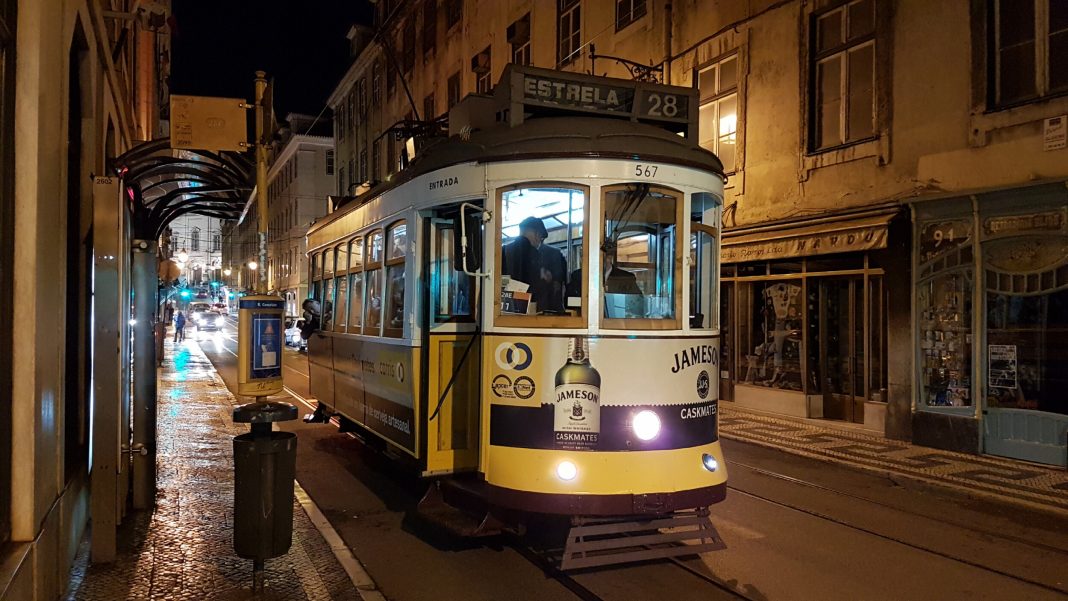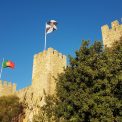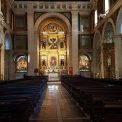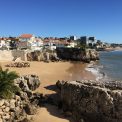Golden Gate Bridge, Statue of the Savior, adrenaline-filled historic trams that will make your blood freeze in your veins. Yes, you might have thought of San Francisco or Rio de Janeiro, but we are not talking about America at all. All these attractions are within reach in one of the main European cities – Lisbon. Along with the world’s largest technology conference – Web Summit, held annually in November, you can combine a pleasant visit with technological innovations. You also have the opportunity to visit the pilgrimage site of Fatima, where allegedly in 1917 the Virgin Mary appeared a hundred years ago.
 Detailed map of our points of interest[/caption>
Detailed map of our points of interest[/caption>
Contents
Day 1 – Old Town Baixa and the legendary tram no. 28
Day 2 – Belém district and São Jorge Castle
Day 3 – Fairytale castles in Sintra
Day 4 – Santa Justa Elevator, Bairro Alto district, and Oriente
Day 5 – Beaches in Cascais and The Cristo Rei statue
Day 6 – Pilgrimage site Fatima
Facts about Lisbon:
- Lisbon was struck by one of the most devastating earthquakes in human history in 1755, resulting in the death of around 100,000 people
- The most famous Portuguese explorer Vasco da Gama made the first voyage to India from Lisbon in 1497
- The Ponte 25 de Abril Bridge is the European version of the Golden Gate Bridge in San Francisco (originally named Ponte Salazar after the Carnation Revolution on April 25, 1974)
- The Vasco da Gama Bridge is the longest bridge in Europe, spanning over 17 km
- The 28-meter statue of Jesus Christ has been overlooking the city since 1959
- The Lisbon Oceanarium is the largest in Europe
- The city is built on seven hills, similar to Rome
- Historic trams, funiculars, and elevators are typical means of transport
- Unique tiles called azulejos adorn almost all buildings
- Typical small cakes filled with a custard mixture are a local specialty
- Cabo da Roca, the westernmost point of Eurasia, is only an hour and a half drive from Lisbon
- Every November, Lisbon hosts the world’s largest technology conference – Web Summit
Day 1- Old Town Baixa and the legendary tram no. 28

As mentioned before, the idea for this trip was influenced by the conference Web Summit. With 60,000 participants, it ranked among the world’s largest tech conferences this year. More information can be found in a separate section at the end of the article.
There are several flight options to Lisbon. Only one airline, TAP Portugal (whose flights are sold by Austrian Airlines), flies directly from Vienna. A cheaper alternative with a layover in Madrid, for example through Iberia, was the option we chose as well. From Budapest, the low-cost carrier Wizz Air offers direct flights, but since it’s a popular destination, expect higher prices.
The approach to Lisbon is perfectly planned. The plane first flies over the mainland into the wider Atlantic so you can see the beaches from above. The cherry on top is flying past the 25 de Abril Bridge, reminiscent of the Golden Gate Bridge, and the Sanctuary of Christ the King, resembling the statue in Rio de Janeiro. Lisbon has only one airport right in the center, so you’ll feel like skimming the rooftops of buildings during landing. But no need to worry, everything is carefully planned 🙂
TIP: You can see the Golden Gate Bridge and the Statue of Christ the King on the right side of the plane, so choose your seat wisely 🙂
From the airport to the center, take the red metro (linha Vermelha); you have two options – switch to the green metro (linha Verde) at Alameda station or continue to the end at San Sebastiao and change to the blue metro (linha Azul). The Lisbon metro has been operating since 1959. In addition to the metro and trams, Lisbon’s typical modes of transportation include funiculars and elevators.
Regarding tickets, the most cost-effective choice is the 24-hour pass for metro/trams/buses/funiculars/elevators at €6.30 (Carris). If you want to include ferries (Transtejo), the price is €9.35, or for suburban trains (CP) you will pay €10.50. During the Web Summit, a special 5-day pass could be purchased for €25, which also covered suburban trains. Another option is the Lisboa card (€40 / 72h), which didn’t seem as advantageous to us. It might be worth it if you plan to visit attractions and museums from morning till night.Accommodation Martim Moniz Guesthouse was our strategically chosen place near the center. Martim Moniz is one of the main squares and also the starting point of the legendary Tram 28. And why is it so legendary? At first sight, it looks like a historical tram, but under the hood, it’s a fine-tuned machine with reinforced brakes, taking you through the narrowest streets of the old city. The route passes by major landmarks, and at some points, you’ll feel like you can see right into people’s kitchens. Cars will back up in front of you, and as the tram descends a hill, your blood might freeze in your veins, wondering if the driver will brake in time. Be prepared, as this ride will become addictive.
TIP: Riding Tram 28 is most cost-effective with a 24h ticket for €6.30, otherwise, you pay €2.90 (standard tram ticket) on board.
We disembark from the tram at Praça do Comércio, which translates to Commerce Square. Historically, it served exactly that purpose. It is the largest and, in our opinion, the most beautiful square in Lisbon. The majestic triumphal arch Arco da Rua Augusta is the gateway from Rua Augusta street. In the center of the square stands a statue of King José I on horseback, symbolically trampling snakes with the horse’s hooves.
Day 2 – Belém District and São Jorge Castle

Lisbon, among other things, is a city of explorers. All major landmarks honoring them are found in the Belém district. You can reach it by taking tram 15 from Praça da Figueira square and getting off at Mosteiro dos Jerónimos stop. The half-hour ride goes alongside the Tagus River, passing beneath the famous Ponte 25 de Abril Bridge.
Jerónimos Monastery(Jerónimos Monastery) is a magnificent monastery built in the Manueline style, erected in honor of overseas voyages to India. The entrance fee for a tour is 10€. Avoid Sundays and holidays when locals have free admission. The main part features a square courtyard adorned with intricately detailed vaults and columns. A perfect experience. The second part of the tour includes the Church of Santa Maria de Belém, where the Portuguese King Manuel I is buried, along with a tomb of Vasco da Gama.
Across from the monastery is a park that leads us to the Monument to the Discoveries (Padrão dos Descobrimentos). The monument depicts 33 Portuguese personalities and served as the departure point for navigators on their overseas voyages. At the top, there is an observation deck accessible either by a paid elevator or by stairs. Next to the water, there is an iron structure in the shape of large letters spelling LOVE adorned with attached padlocks. The mosaic pavement in front of the monument shows a map of the world with the routes of Portuguese navigators marked. The city received the mosaic as a gift from the Republic of South Africa in 1960. A promenade along the Tagus River leads from the monument. Along the way, there is a cycling and running track, the Belém Lighthouse, and in the distance, the Belém Tower.
Belém Tower (Torre de Belém) is a fortified tower from the 16th century and is one of the city’s symbols. The tower originally stood on a small island, but after years of river sedimentation, it became connected to the mainland. An interesting fact is that the first rhinoceros brought from India perished in a shipwreck, but its likeness is preserved on the tower. The entrance fee to Belém Tower is 6€, and it is advisable to avoid crowds on Sundays and holidays.
TIP: A combined ticket to the Jerónimos Monastery and Belém Tower costs 12€.
Both Belém Tower and the Jerónimos Monastery are UNESCO World Heritage sites. If you have enough time, stop for a pastry at Pasteis de Belém. Only in this neighborhood will you find pastries made according to the original recipe.
In the afternoon, we have planned a visit to São Jorge Castle, the highest point in Lisbon. Bus number 737 from Praça da Figueira square goes directly to the castle. Another option, which we used, is – unsurprisingly – the legendary tram number 28. We get off at the Santa Luzia viewpoint, where you can enjoy a view of luxury ships. Through narrow streets heading uphill, we reach the main entrance. It is the only entrance, and the entrance fee is 8.50€.
The tour starts with a park and viewpoints over Lisbon. From this vantage point, you will have all the main landmarks at your fingertips. The Commerce Square, the Santa Justa Lift, the Carmo Convent, or in the distance, the Christ the King Sanctuary and the 25 de Abril Bridge. Lisbon is a city of seven hills, noticeable in the hilly terrain of the old town. The lowest part is Baixa, above it is the party district Bairro Alto, and now we are in the oldest district, Alfama. In addition to the city, you can see all the planes landing on the horizon.The castle itself has a touch of medieval fortress. The Portuguese and Lisbon flags fly on the towers. We enter the castle courtyard through a small bridge. We climb up the stairs to the ramparts, where you can see all four cardinal points. The greatest spectacle was the sunset over the 25th of April Bridge. The last part of the tour is the archaeological museum. We ride back from the castle by bus number 737.
As for food, we have come to appreciate the Dom Joao Restaurant, located near the Tesouro da Baixa hotel. We taste delicious paella and enjoy some sangria. For breakfast, we have stopped several times for excellent seafood baguettes. It is common practice that restaurants serve olives and bread rolls at your table, even if you haven’t ordered them. The rule is, if you don’t eat them, they won’t charge you for them.
The Baixa district is relatively calm in the evening. We only encounter a few guys here trying to sell us marijuana or hashish. You can catch them off guard by jokingly approaching them first with an “offer” 🙂
TIP: Try the local drink ginjinha (shortened to ginja); it’s like a cherry liqueur.
On the contrary, the busiest district is Bairro Alto, where all the young and party-goers gather in the evening. There are several ways to get there. You can take tram number 28, Santa Justa Lift elevator, Gloria Funicular tram, or walk up. The most reliable option is the Gloria Funicular, which runs until midnight. The elevator operates until 23:00 in the summer and only until 21:00 in winter, but we’ve had the experience of arriving at 20:45 and it was already closed.
We find ourselves in the Bairro Alto district, full of bars, taverns, and restaurants. A good meeting point is the Cheers Irish Pub. The establishments will lure you in with special offers or free shots. The price of beer ranges from 2.50€ to 5€. If you’re a larger group, you can practically have the place to yourselves, and the DJ will play even Slovak songs with no problem. And you won’t be alone if you party until dawn 🙂
Day 3 – Fairytale castles in Sintra

Today we are going on a trip outside of Lisbon to the fairytale town of Sintra. The trains are operated by the CP company, and the best starting stop is Rossio station. The journey takes about 40 minutes. From the station, you need to walk to the right to bus number 434. The castles and palaces are on big hills, so if you don’t want to hike all day, this is the only option. The bus does a circuit for 5€ (payment is in cash only), which means it will drop you off at the castles, and after the tours, you hop on the next one, which will take you back to the station.
During the ride, we pass by the Royal Palace Palacio Nacional de Sintra, with its unmistakable conical turrets. Our first planned stop is the medieval castle Castle of the Moors. It was built by the Moors in the 8th and 9th centuries and is now part of the UNESCO heritage. The entrance starts with a stone path that winds uphill. From the courtyard, you reach the ramparts, which form one long ascending belt. You’ll work up a bit of sweat on these stairs to heaven, but with those amazing views, you’ll forget about the fatigue right away. The end of the mainland and the endless Atlantic are within stone’s throw. The Royal Palace in Sintra is also within sight. Once we climb to the highest point, a beautiful view of the neighboring fairytale Pena Palace opens up to us. It’s literally a Disney-esque castle in yellow-red color, and we are looking forward to seeing it up close.
We move between the castles on foot, so we don’t have to wait for the next bus. Pena Palace is one of Portugal’s seven wonders, and we can only agree. This love nest was built by King Ferdinand II of the House of Saxe-Coburg and Gotha in the year of his wedding. He invited distinguished architects and tasked them with building a palace straight out of a fairy tale. The fairy-tale entrance gates, clock tower, courtyard with oriental arches, and views of the Atlantic and the Castle of the Moors are amazing. From the interior, I’ll mention the chapel, royal dining room, hunting collection, and the kitchen is also interesting.
Unique is also the park surrounding the castle, which has a labyrinthine system of paths. The king ordered trees from various distant lands to be planted there, including the North American sequoia, Lawson’s cypress, magnolia, yew, Chinese ginkgo, Japanese cedar, and a wide range of ferns and tree ferns from Australia and New Zealand. Since 1995, the castle has been on the UNESCO World Heritage List.
TIP: A combined ticket for the Moors Castle + Palace of Pena is 5% cheaper than buying each separately.
If you have enough time, you can also visit the westernmost point of Portugal and indeed all of Eurasia – Cabo de Roca. You can get there from Sintra by bus no. 403 in half an hour.
Day 4 – Santa Justa Elevator, Bairro Alto and Oriente District

Santa Justa Elevator is the most significant technical landmark of the city. The 45-meter-high iron structure is built in neo-gothic style with various decorations across the floors. Its resemblance to the Eiffel Tower is no coincidence, as it was designed by a Portuguese pupil of Gustave Eiffel. The elevator has adorned Lisbon since 1902. In its first year of opening, half a million people visited, and its popularity rivaled that of the Eiffel Tower. Originally powered by a massive steam engine, it was converted in 1907 to a much safer and cleaner electric motor, which still powers the elevator today. The two wooden cabins and the authentic touch are complemented by the uniformed operator.
TIP: You have access to the elevator and viewpoint with a 24-hour ticket; otherwise, you would pay €5.15.The elevator, besides connecting the two districts of Baixa and Bairro Alto, offers a magnificent panoramic view of the entire Lisbon. After exiting the cabin, a few spiral stairs lead to the viewpoint. You will enjoy romantic views of the São Jorge Castle, one of the most beautiful squares, Rossio Square with the national theatre, as well as the ruins of the Carmo Convent, where airplanes can be seen landing overhead. It’s hard to leave this place and definitely worth a visit, even in the evening.
From the elevator, a path leads past the ruins of the convent to Carmo Square. The convent church used to be one of Lisbon’s main churches but ended up in ruins after the 1755 earthquake and was never reconstructed. Despite being just ruins, the church remains one of Lisbon’s main landmarks. The broken Gothic arches attest to its ancient beauty. Today, it also houses an archaeological museum.
A visit to the unassuming 16th-century Jesuit church Igreja de São Roque is worth it. The church’s unremarkable facade hides a rich interior composed of several chapels. The most extravagant is the Chapel of Saint John the Baptist (Capela de São João Baptista), built in Rome using the most expensive materials like amethyst, alabaster, agate, lapis lazuli, and Carrara marble. After being consecrated by Pope Benedict, the chapel was dismantled and transported to Lisbon.
TIP: A free city guide starts from Praça Luís de Camões every day in winter at 10:00 and 15:00 (October to March) and in summer at 10:00 and 16:30 (April to September).
One of the most modern parts of Lisbon is Oriente, where the Web Summit conference is held. You can reach it by taking the red metro line through the transfer nodes São Sebastião (blue line) or Alameda (green line). The Gare do Oriente station was designed by the renowned Spanish architect Santiago Calatrava for the Expo 98 exhibition. It is famous for its heavy structure resembling bones.
Exiting the futuristic station, you will see the large Vasco da Gama shopping center in front of you, flanked by two sail-shaped towers. Some of the most expensive apartments in the city are located here. Next is the multifunctional Altice Arena stadium, with a capacity of 20,000 people. To the right of the stadium is the Lisbon Oceanarium, the largest in Europe and the most visited attraction in Portugal. Entrance fee is €16.20.The technological advancement is complemented by a cable car that operates above the water between the oceanarium and the Vasco da Gama Tower. Vasco da Gama Tower is the tallest building in Lisbon with its 145 meters. The tower was transformed into the luxurious MyRiad hotel in 2012, resembling the Burj Al Arab hotel in Dubai. From the cable car and the promenade, there is a beautiful view of the Vasco da Gama Bridge. The bridge has an estimated lifespan of 120 years and was designed to withstand wind speeds of 250 km/h and survive an earthquake 4.5 times stronger than the historic 1755 earthquake.
Day 5 – Beaches in Cascais and The Cristo Rei statue

Cascais and Sintra are two main tourist areas just a short distance from Lisbon. The train to Cascais departs from the Cais do Sodré station, accessible by the green metro line. The journey takes about 40 minutes and follows the coastline past the 25th of April Bridge, the Savior Statue, and various beaches. Among the most visited beaches is Carcavelos Beach with the impressive Forte de São Julião da Barra fortress, located about two-thirds of the way. The final stop in Cascais is right by other beaches – Praia da Conceição, Praia da Rainha, and Praia da Ribeira. The beaches are predominantly sandy, and the windy conditions are particularly appreciated by surfers and windsurfers. The pedestrian zone offers plenty of modern shops, small pubs, bars, cafes, and restaurants serving fish specialties.
The Cascais Citadel is a set of fortifications built between the 15th and 17th centuries to defend the coastline and protect against attacks on the main city of Portugal. The Citadel comprises three separate buildings – the Santo António de Cascais tower, the Nossa Senhora da Luz de Cascais fortress, and the former Royal Palace area. Beyond the citadel is the square-shaped Santa Marta Lighthouse with an unconventional lighthouse museum established by the Portuguese navy. Continuing west, you will encounter the dramatic Boca do Inferno. It is a high rocky cliff where water has carved various formations, including the “mouths of hell.” The water clashes and mixes uniquely in these formations, sometimes giving the feeling of pure froth emerging from them.
In the evening, we planned to visit the Christ the King Sanctuary. The statue of Jesus Christ stands on the other side of the Tagus River in the Alameda area. The best transportation connection, included in a 24-hour ticket, is from the Marquês de Pombal monument by bus number 753. After crossing the 25th of April Bridge, alight at the first stop at Portagem. Walk over the pedestrian bridge above the road and take the nearest streets uphill.A 28-meter statue of Christ on an 82-meter pedestal has been overlooking Lisbon since 1959. It was built to express gratitude for the Portuguese being spared from the horrors of the Second World War. On the pedestal, you can notice a huge inscription saying obrigado = thank you. The elevator to the viewpoint cost 5€. The viewpoint is at the mentioned height of 82 meters and provides a beautiful panoramic view of Lisbon and the 25th of April Bridge. We arrived just before sunset, so we were able to enjoy the sunset and the illumination of the entire bridge.
On the way back, we confirmed that kind-hearted people live in this area. It was windy, so we stopped at a small café for a glass of ginjinha. A nice gentleman apologized for not accepting card payments, so we dug out the last coins we had. He then started chatting with us and began bringing whole bottles of Ginjy and typical spirits to the counter for us to enjoy. To top it off, he seated us at a table and added olives, pickled beans, and other delicacies to the offer. This was a first-time experience for us. Of course, in the end, we scraped together all the change we had left and thanked him kindly.
Day 6 – Pilgrimage site Fatima

From May 13 to October 13, 1917, the Virgin Mary allegedly appeared to three small children – siblings Francisco, Jacinta, and their friend Lucia – in Fátima near an oak tree. The Catholic Church recognized the authenticity of the apparitions in 1930. Since then, thousands of Christians have flocked here to honor the Virgin Mary as the Queen of the Holy Rosary.
Buses to Fátima depart from two locations – Sete Rios and Oriente. We departed from Oriente as there was a conference happening there. The bus stops are in the opposite direction from the Vasco da Gama shopping center. We bought a round-trip ticket for 22.60€ at the Renex counter. Only cash payments were accepted. The journey to Fátima takes about an hour and a half and mostly follows the highway. The bus stop in Fátima is just a few minutes from the Basilica of Our Lady of Fátima. Just walk along the main road; you can’t get lost.
Over time, the area around the oak tree has been transformed into a large square, roughly twice the size of Saint Peter’s Square in Rome. At one end of the square stands the gigantic Basilica of Our Lady of Fátima, built in a neoclassical style with a central tower 65 meters high. Construction began in 1928 and was completed in 1997. The basilica houses the tombs of Francisco and Jacinta, who died shortly after the apparitions as predicted by the Virgin Mary. In 2000, they were beatified by Pope John Paul II. The third child, Lúcia dos Santos, passed away in 2005, and the beatification process is currently ongoing.
Near the oak tree, the Chapel of the Apparitions was built, where daily masses are held in various languages, most of which can be watched online. Inside the chapel, there is a statue of the Virgin Mary behind glass. On Mary’s crown, there is a bullet that hit John Paul II during an assassination attempt on the anniversary of the first day of the apparitions on May 13, 1981. The bullet was offered by John Paul II to the Virgin Mary as a gift because he believed that she had deflected the assassin’s hand at the moment of the shot, causing the bullet to narrowly miss his aorta.The other side of the square is adorned with a modern Basilica of the Holy Trinity, whose foundation stone was blessed by the Holy Father. The rock of this foundation stone comes from the tomb of St. Peter.


































































